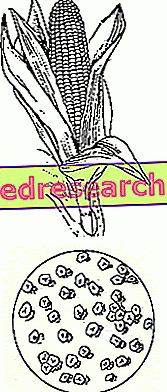See also: starch - rice starch - corn starch - wheat starch - potato starch
What is that
Corn starch is a multifaceted food product, just like the shape of the granules that make it up.
Observing it under a microscope, it is in fact possible to recognize particles of fairly uniform size (20/30 μm) and of polyhedral shape, with rounded corners and sometimes with a radial central slot.

Properties and Uses
Corn starch, also known as cornstarch, is the cheapest flour that exists; if combined with water, it increases in volume by swelling and increasing the consistency of the product; for this reason, scrutinizing the ingredients of common food products, we notice the omnipresence of corn starch, often followed by the modified adjective (its chemical structure is modified, through acids or enzymes, to exalt particular characteristics).
Amylose and Amylopectin
The properties of corn starch depend on the content of amylose and amylopectin, which in the original product are present in percentages of 30 and 70% respectively.
- Amylose, a linear glucose polymer, is less digestible, keeps cooking better and is responsible for the refining process at the end of cooking.
- Amylopectin, a branched polymer of glucose, is more easily digested, has a higher glycemic index and during cooking tends to gel and spill out of the product, making it sticky and viscous.
Nutritional characteristics
The characteristics of amylopectin are much sought after by the agri-food industry, which not by chance led to the selection of the so-called "Waxy" maize (also called waxy maize), practically devoid of amylose. This type of corn is usually used to thicken fruit jellies and to give greater consistency to canned or frozen foods. In the labels it is mentioned under "corn starch".
Unfortunately, as anticipated, the glycemic index of this product is very high (almost equal to 100); poor nutritional value, given the absence of vitamins and mineral salts, high glycemic index and high calorific value, make this corn starch a sort of food for human beings, ideal for making them fat in the shortest possible time. Not only that, if we take for example a yogurt or a fruit juice adulterated with corn starch, these will be poorer than their original nutrients, given that this additive saves on the quality and quantity of the basic ingredient. The same goes for sausages, cheeses and many other processed products.
Production
Corn starch is obtained from the grains of the homonymous plant ( Zea mays ), placing the kernels in a solution of sulfur dioxide. The softened grains are then subjected to a cycle of grinding, from which a suspension formed by a heavier starch and a lighter gluten is obtained, which are separated by centrifugation. First, however, it is necessary to extract the oleaginous embryos, used for the production of corn oil.
The last phase of the production process consists in drying and reducing the starch to dust.
Celiac disease
Due to the absence of gluten, corn starch is indicated for the celiac diet, replacing poorly tolerated wheat flour. However, unless the product is marked with a barred ear, the risk of contamination of corn starch with wheat gluten is still present, due to the promiscuity of many food processing plants.



